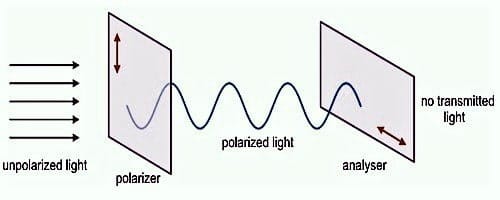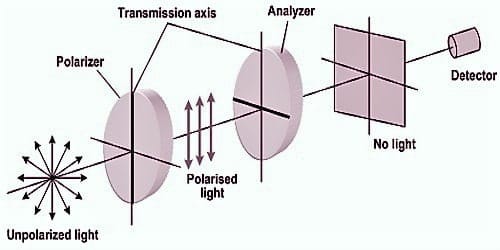A device which produces plane polarized light is called a polarizer. A device which is used to examine, whether light is plane polarized or not is an analyzer. A polarizer can serve as an analyzer and vice versa.
A ray of light is allowed to pass through an analyzer. If the intensity of the emergent light does not vary, when the analyzer is rotated, then the incident light is unpolarized; If the intensity of light varies between maximum and zero, when the analyzer is rotated through 900, then the incident light is plane polarized; If the intensity of light varies between maximum and minimum (not zero), when the analyzer is rotated through 90o, then the incident light is partially plane polarized.
Polarizer and Analyser are similar. Polarizers and analyzers are parts of optical instruments that use flat polarized light. There are many types of polarizers and analyzers that can be selected according to our needs. The difference is in the use of them. A polarizer can filter light waves in order to produce polarization of light. In other words, a polarizer can produce plane polarized light from light waves coming from a usual light source. A polarizer is used to polarize the light while the analyzer is used to confirm the polarized light which comes from polarizer that whether it is polarized or not. The analyzer acts as a subsequent polarizer. A polarizer can filter light waves in order to produce polarization of light.

Differences:
A polarizer and an analyzer are two necessary mechanisms for a polarized light microscope. The main dissimilarity between polarizer and analyzer is that polarizer produces plane polarized light whereas analyzer is used to check whether the light has been polarized or not.
Definition
- Polarizer: Polarizer is any mechanism that can change white light into plane-polarize light.
- Analyzer: an Analyzer is a machine used to decide whether the light is plane polarized or not.
Polarization
- Polarizer: Polarizer can make a light beam a plane polarized beam of light.
- Analyzer: Analyzer can also act as a polarization device but its major function is to perceive whether the light has been polarized.
Placement in Polarizing Microscope
- Polarizer: Polarizer is placed under the sample.
- Analyzer: Analyzer is located above the sample.
Movement
- Polarizer: Polarizer can be rotated 3600.
- Analyzer: Analyzer can be moved in or out of the path of light.
Uses
- Polarizer: Polarizer is used to polarize the light coming from a light source.
- Analyzer: Analyzer can be used to decide whether the light is polarized or to decide whether the sample is birefringent.
Polarizers and analyzers are used in polarized light microscopy. Although both polarizers and analyzers are used as light filters, there are differences in their applications. In other words, a polarizer can produce plane polarized light from light waves coming from a usual light source. Polarizers and analyzers are parts of optical instruments that use plane polarized light. The key dissimilarity between polarizer and analyzer is that polarizer produces plane polarized light whereas analyzer can be used to check whether the light has been polarized or not.














